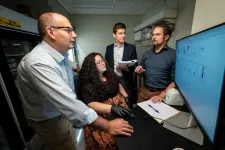(Press-News.org) (MEMPHIS, Tenn. – August 17, 2023) St. Jude Children’s Research Hospital scientists, in collaboration with the Institute of Environmental Science and Research (ESR) Limited, found that immune cells present in people months before influenza (flu) infection could more accurately predict if an individual would develop symptoms than current methods which primarily rely on antibody levels. The study found certain immune cells were associated with increased protection, while other immune cells were associated with increased susceptibility to developing symptoms after catching the virus. The findings have implications for new approaches to public health and were published today in Nature Immunology.
“We’ve been struggling for decades, if not centuries, with why some people get sick with infections and some don’t,” said co-corresponding author Richard Webby, Ph.D., St. Jude Department of Host-Microbe Interactions. “This is one of the best attempts to try and figure that out for influenza. We were able to measure many different immune parameters from a single blood draw and correlate them with protection from, or susceptibility to, infection symptoms.”
Functional diversity improves anti-influenza immune performance
The researchers found that having a more functionally diverse set of immune cells was correlated with increased protection from flu symptoms. The group identified these cells by comparing the immune cells present in the blood of patients who had symptoms from flu infection to those who were asymptomatic or uninfected. The blood samples, taken up to six months before that flu season, showed very different sets of immune cells in the two groups. Those without symptoms not only had a more functionally diverse set of immune cells but those cells were also associated with an influenza-specific long-term response, sometimes called the memory response. Patients with symptoms tended to have a more similar set of inflammatory immune cells, which are more likely to be involved in a nonspecific, functionally narrow and short-term response.
The analysis included volunteers in the surveillance for a community cohort-based influenza-like illness (SHIVERS-II) study in New Zealand. SHIVERS-II includes a unique cohort of volunteer patients that the study tracks over time, including their health information. For this study, the volunteers regularly had their blood drawn so the scientists could characterize their immune cells and find which were associated with protection from flu symptoms.
“The SHIVERS platform, which represents a long-running collaboration between St. Jude and ESR, has been tremendously successful because of the willingness of participants to stay engaged in the study,” said co-corresponding author Sue Huang, Ph.D., principal investigator for SHIVERS-II and the World Health Organization National Influenza Centre director at ESR. “It is great to see their efforts coming to fruition.”
“Our results show that the balance of different immune cells in people can be extremely biased,” said senior and co-corresponding author Paul Thomas, Ph.D., St. Jude Department of Immunology. “You might build up an immune cell army that is exceptional at fighting off one kind of infection, but then that can make you feel sicker from another kind of infection. By understanding which immune cells are the best for fighting the flu, we can start designing vaccines to push for those populations that are most protective.”
“The baseline immune state before vaccination is known to significantly vary across age, sex, vaccination status, infection history and more,” said co-first author Aisha Souquette, Ph.D., St. Jude Department of Immunology. “By understanding the different types of immune profiles that can provide protective responses, we can tailor and optimize our vaccine platforms for populations with distinct baseline immune states.”
For developing future tailored approaches, pushing for a particular type of cell or particular immune proteins, such as antibodies, is less important than evaluating the collective contributions of all the immune cells, which may be easier than current methods.
“We observed that the protective, or susceptibility, cell profile’s makeup is less important than the overall, often converging, function,” said co-first author Robert Mettelman, Ph.D., St. Jude Department of Immunology. “This means that we can more broadly evaluate protection or susceptibility at the level of a cell profile, making it easier to evaluate across studies.”
Indeed, this study showed that those vaccinated for the flu generally had increased protective anti-flu immune cells, improving their chance of avoiding symptoms. Those rarer individuals who were unvaccinated and avoided symptoms seemed to have a set of immune cells that mimicked the functions of the protective cells in the vaccinated population. This may explain why some people are less affected by the flu, even when unvaccinated, than others, but it still suggests vaccination creates the best chance of avoiding symptoms. One way to encourage this vaccine uptake is to determine the inherent risk in staying unvaccinated accurately.
Improving risk predictions by adding to antibodies
With the cell types associated with protection or susceptibility from flu now identified, the future promises improved influenza risk prediction. Clinicians and vaccine developers have traditionally predicted influenza susceptibility by looking at anti-flu antibodies in the bloodstream. Antibodies are proteins that interfere with a virus’s ability to infect cells. They are produced by a special kind of immune cell called a B-cell. This study shows the presence of a diverse set of immune cells, with a high proportion of helper T cells, a cell involved in the long-term immune response that “helps” B cells, was more predictive of protection than looking at antibodies alone.
“We were surprised that just by identifying the particular cellular populations and combing it with the serological antibody data, we could make such robust predictions,” Thomas said. “We may have the tools to understand susceptibility to infection already in our hands. We can only do it in the lab now, but it’s surprising and potentially exciting that, someday, we may get to a point where we can easily identify at-risk people and provide targeted support.”
In addition to the robustness of predictions from looking at cell types, the timing was also unexpected. The samples were taken up to six months before flu infection occurred but still produced strong predictions, opening new possibilities for public health.
“The exciting thing is that we could identify a subset of people at the beginning of the flu season that may be more likely to get symptomatic influenza,” Webby said. “We could predict who may be at risk well before the virus is even in the population. I don’t think we’ve really been in a position to even think about that before — this could open up new opportunities to prevent flu-based morbidity.”
While influenza researchers may now have new opportunities in flu prevention revealed by the study, its results also confirmed a long-standing message from virology and immunology.
“Our results reemphasize that vaccination prevents influenza symptoms, and now we can point to the increased levels of those immune cells correlated with that protection,” said Thomas. “Get your annual flu vaccine.”
Authors and funding
The study’s co-first authors are Robert Mettelman and Aisha Souquette, of St. Jude. The other authors are Lee-Ann Van de Velde, Kasi Vegesana, E. Kaitlynn Allen, Christina Kackos, Sanja Trifkovic, Jennifer DeBeauchamp, Taylor Wilson, Deryn St. James, Smrithi Menon, of St. Jude; Timothy Wood, Lauren Jelley, Judy Bocacao, Jacqui Ralston, Wendy Gunn, Nayyereh Aminisani, Ben Waite, R. Pamela Kawakami, Institute of Environmental Science and Research Limited (ESR), Wallaceville Science Centre; Jessica Danielewicz, Institute of Environmental Science and Research Limited (ESR), Mt Albert Science Centre; Annette Nesdale, Michelle Balm, Te Whatu Ora Health New Zealand; Nikki Turner, University of Auckland; and Tony Dowell, University of Otago.
The study was supported by grants from the surveillance contract (HHSN272201400006C), US Department of Health and Human Services (75N93021C00016 for the St. Jude Centers of Excellence for Influenza Research and Response, 75N93019C00052 for the Center for Influenza Vaccine Research for High Risk Populations of the Collaborative Influenza Vaccine Innovation Centers), National Institute of Allergy and Infectious Diseases (3U01AI144616-02S1, U01AI150747, R01AI154470 and F32AI157296) and ALSAC, the fundraising and awareness organization of St. Jude.
The content is solely the responsibility of the authors and does not necessarily represent the official views of the National Institutes of Health.
St. Jude Media Relations Contacts
Michael Sheffield
Desk: (901) 595-0221
Cell: (901) 379-6072
michael.sheffield@stjude.org
media@stjude.org
Rae Lyn Rushing
Cell: (901) 686-2597
raelyn.rushing@stjude.org
media@stjude.org
St. Jude Children's Research Hospital
St. Jude Children's Research Hospital is leading the way the world understands, treats and cures childhood cancer, sickle cell disease and other life-threatening disorders. It is the only National Cancer Institute-designated Comprehensive Cancer Center devoted solely to children. Treatments developed at St. Jude have helped push the overall childhood cancer survival rate from 20% to 80% since the hospital opened more than 60 years ago. St. Jude shares the breakthroughs it makes to help doctors and researchers at local hospitals and cancer centers around the world improve the quality of treatment and care for even more children. To learn more, visit stjude.org, read St. Jude Progress blog, and follow St. Jude on social media at @stjuderesearch.
END
Immune cells present long before infection predict flu symptoms
2023-08-17
ELSE PRESS RELEASES FROM THIS DATE:
Victims of partner violence and child abuse face a significantly increased risk of developing type 2 diabetes later in life
2023-08-17
Ann Arbor, August 17, 2023 – According to the results of a new study in the American Journal of Preventive Medicine, published by Elsevier, exposure to interpersonal violence throughout childhood or adulthood increases an individual’s chance of developing adult-onset diabetes by more than 20%. Data showed the risk level is similar among adult males and females and lower income Black and White Americans.
Lead investigator Maureen Sanderson, PhD, Department of Family and Community Medicine, Meharry Medical College, explained, “While previous research has linked exposure to interpersonal violence with a higher risk for developing ...
Powerful imaging technology used to investigate renal disease
2023-08-17
Chandra Mohan, Hugh Roy and Lillie Cranz Cullen Endowed Professor of biomedical engineering, is reporting the first use of the powerful imaging mass cytometry (IMC) to examine the kidneys of patients with lupus (systemic lupus erythematosus), an autoimmune disease that can affect multiple organs and become fatal, and to diagnose lupus nephritis (LN) in those patients.
LN is a severe inflammation of the kidneys and a major cause of death in lupus patients. Up to 60% of SLE patients will develop renal symptoms with 5–20% of those patients progressing to end stage kidney disease within 10 years.
IMC can showcase ...
Argonne researchers power up: Co-awarded 9 nuclear projects from Department of Energy
2023-08-17
Engineers from the U.S. Department of Energy’s (DOE) Argonne National Laboratory are collaborating on nine projects awarded to universities under the DOE’s Nuclear Energy University Program (NEUP) and Integrated Research Projects.
The projects were selected as part of DOE’s commitment to investing in nuclear energy technologies, universities and the development of the next generation of researchers and scientists. These projects will play a vital role in advancing nuclear technology, supporting early career faculty research activities and fostering student innovation at Argonne ...
Policy to expand Medicaid coverage linked to higher participation in cancer clinical trials among people insured by Medicaid
2023-08-17
SEATTLE – AUGUST 17, 2023 – The Medicaid expansion under the Patient Protection and Affordable Care Act resulted in a 19% annual increase in Medicaid-insured cancer patients participating in publicly funded clinical trials, according to researchers from Fred Hutchinson Cancer Center, the SWOG Statistics and Data Management Center and Columbia University.
Published in JAMA Oncology, the study explored the impact of Medicaid expansion in 2014 and 2015 on cancer clinical trial participation. Researchers found that the 19% annual increase, compounded over time, resulted in 52% more patients with Medicaid insurance participating ...
New call for joint effort to bolster research integrity
2023-08-17
Who’s responsible for upholding research integrity, mitigating misinformation or disinformation and increasing trust in research? Everyone – even those reporting on research – says a new article published by leading research integrity experts.
In their paper published in the journal Frontiers in Research Metrics and Analytics, Dr Leslie McIntosh (Vice President Research Integrity, Digital Science) and Ms Cynthia Hudson Vitale (Director, Science Policy and Scholarship, Association of Research Libraries) call for improved policies and worldwide coordination between funding bodies, publishers, academic institutions, scholarly ...
New UCF project examines key role soils play in keeping the planet cool
2023-08-17
UNIVERSITY OF CENTRAL FLORIDA
New UCF Project Examines Key Role Soils Play in Keeping the Planet Cool
The research, funded by a grant from the USDA National Institute of Food and Agriculture, will examine a method to keep carbon from escaping soils and trapping heat in Earth’s atmosphere.
ORLANDO, Aug.17, 2023 – A new project from the University of Central Florida is looking to the soils for a way to cool the skies.
Funded by a nearly $750,000 grant from the USDA National Institute of Food and Agriculture, the research will examine a method to keep carbon from escaping soils and ...
Rotman professors and Ph.D. students honored at academic conferences
2023-08-17
August 17, 2023
Rotman Professors and PhD Students Honoured at Academic Conferences
Toronto – Faculty and doctoral students at the University of Toronto’s Rotman School of Management were honoured at recent academic conferences for their research and contributions.
At the annual meeting of the American Accounting Association last week in Denver, Jee-Eun Shin, an assistant professor of accounting, received the Best Early Career Researcher in Management Accounting Award sponsored by the Association of International Certified Professional Accountants. ...
University of Colorado data researchers connect diet to changes in the microbiome
2023-08-17
“Should I be taking a probiotic?” is a question that Maggie Stanislawski, PhD, assistant professor in the University of Colorado Department of Biomedical Informatics (DBMI), gets asked often.
The answer is complicated. Every person’s gut microbiome is unique, and many probiotic supplements sold in grocery stores may not effectively bolster gut health for everyone, she says. The researcher, who specializes in the role of the gut microbiome in obesity and cardiometabolic disease, instead points to the importance ...
Largest genetic study of brain structure identifies how the brain is organised
2023-08-17
The largest ever study of the genetics of the brain – encompassing some 36,000 brain scans – has identified more than 4,000 genetic variants linked to brain structure. The results of the study, led by researchers at the University of Cambridge, are published in Nature Genetics today.
Our brains are very complex organs, with huge variety between individuals in terms of the overall volume of the brain, how it is folded and how thick these folds are. Little is known about how our genetic make-up shapes the development of the brain.
To answer this question, a team led by researchers at the Autism Research ...
Discovery of chikungunya virus’s “invisibility shield” may lead to vaccines or treatments
2023-08-17
August 17, 2023—(BRONX, NY)—Researchers at Albert Einstein College of Medicine have found that the virus responsible for chikungunya fever can spread directly from cell to cell—perhaps solving the longstanding mystery of how the virus, now emerging as a major health threat, can manage to escape antibodies circulating in the bloodstream. The findings, published today in Nature Microbiology, could help in developing effective vaccines or treatments for chikungunya fever, a debilitating and increasingly common mosquito-borne disease.
A Possible Explanation ...




